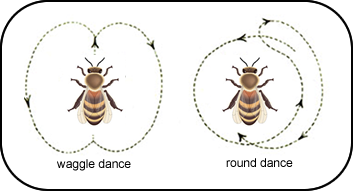All narratives are patterns, but all patterns aren’t narratives, unless they suggest character, setting and action. Animals look for and find patterns. So, we should ask, do animals produce narrative?
 Well, yes. The language of the bees still astounds scientists. Bees communicate symbolically in the form of a dance, passing on information about distance, difficulty and value of potential food sources. They dance in the present about past experiences in order to exploit future resources. Other bees do their little dance, explaining alternative sources of pollen, and then somehow the bees come to a decision about the best source. An insect, a creature from the lower orders – far down the hierarchy of animals (at the top of which we have placed ourselves) – can clearly tell stories and make value judgements about them. (Read all about it in biologist and sociologist Eileen Crist’s article “Can an Insect Speak? The Case of the Honeybee Dance Language” [2004].) The idea is so astounding that I don’t even know what to do with it. I will just move on to dogs, with whom I can converse more easily.
Well, yes. The language of the bees still astounds scientists. Bees communicate symbolically in the form of a dance, passing on information about distance, difficulty and value of potential food sources. They dance in the present about past experiences in order to exploit future resources. Other bees do their little dance, explaining alternative sources of pollen, and then somehow the bees come to a decision about the best source. An insect, a creature from the lower orders – far down the hierarchy of animals (at the top of which we have placed ourselves) – can clearly tell stories and make value judgements about them. (Read all about it in biologist and sociologist Eileen Crist’s article “Can an Insect Speak? The Case of the Honeybee Dance Language” [2004].) The idea is so astounding that I don’t even know what to do with it. I will just move on to dogs, with whom I can converse more easily.
Continue reading “Do Animals Tell Stories?: The Narrative Abilities of Animals”